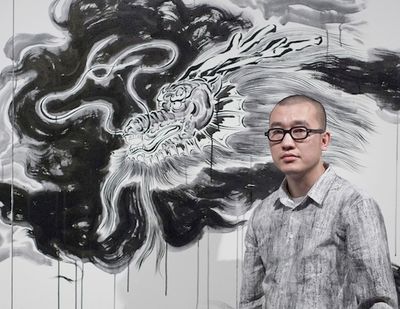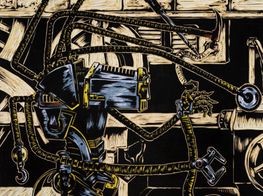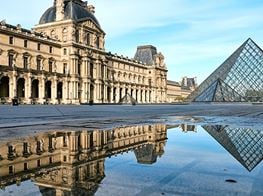Sun Xun on Animation and Storytelling
Sun Xun. Courtesy the artist.

Sun Xun. Courtesy the artist.
Sun Xun is a paradoxical figure: he works with ink but rejects the discourse of cultural purity that accompanies it. Dissects political narratives but takes only vague positions of his own, and runs an animation studio while developing a diverse practice that confronts much more radical questions.
Based in Beijing, where he runs Pi Animation, he is perhaps more closely associated with a southern Chinese school of contemporary art, but continues to defy categorization by easily moving between media and genres, styles and positions. His latest work furthers his exploration of ideology in everyday life, turning to literary history in order to project possible futures and rewrite the recent past. Sun was born in 1980, and is considered one of the most unique voices among the younger generation of Chinese artists working today.
RPHow did you arrive at the idea for this new animation, Brave New World?
SXWhen we started discussing this exhibition the gallery asked me if I would have any interest in doing something with their European program, where Galerie Malingue Paris deals in Old Masters. I really like Magritte, so I started looking at this painting The Spontaneous Generation, which I discovered he created after reading Aldous Huxley's Brave New World.
Reading the novel I found it fitted well with other dystopian literature I was interested in, like Orwell's 1984. This literary tradition matches up well with Chinese history, in that we have progressed from 1984 to Brave New World. I found this very interesting, so in this exhibition I'm following this thread.
RPHow would you position this work within the ongoing revival of ink in Chinese art right now?
SXOf the eighteen animations I've produced, only two or three of them have anything to do with Chinese ink painting. Most of them have nothing to do with it, but because of the current tendency towards ink it appears more obvious here. I use ink and a brush in the work, but I'm not thinking very much about ink as a culture. My interests are elsewhere. I don't want to be labelled with easy tags like ink or animation. They're materials, but I'm not particularly interested in animation or ink themselves. What's much more important is the thinking behind the work, not these superficial gestures.
RPWhy work so consistently with animation and ink if they don't interest you?
SXThey're tools. Animation is just a word, but as a thing animation can link space and time. This is what it signifies. It has its own history and development. Often when we discuss something like this we are really only talking about words and labels. When you see a tree, you think of the word "tree," and only then do you think about what the tree looks like.
This is wrong. You should first forget the concept of "tree" and understand nature outside of language. Otherwise the nature that we know is false—not a real thing at all. People are often interested in the idea of "ink," but they don't often think about what it means to put ink powder together with water. We talk about "animation," but we don't really think about how it moves or what it does. We don't think enough about what animation can bring us on a conceptual or metaphysical level, but rather often get bogged down in vocabulary. That isn't the real work. It's an artificial premise. I'm wary of this. My work shouldn't be defined this way.
What's much more important is the thinking behind the work, not these superficial gestures.
RPThen what is it that does matter most in your work? Concept? Narrative?
SXImage. The image is most important because it is against language. It does not attempt to define. If I say you're a man, of course you'll think this doesn't fully describe you. But you can't say I'm wrong. If I try to be more specific, I can say you're a man who wears glasses. You still can't say I'm wrong, but you still don't agree.
So what's the only way to exhaustively describe you? To make an image. Everything about you is absolutely unique. Language does not allow for this; it cannot sufficiently describe the world. My work should be read through its images, not described. Description is negation. When I say you are a man, I negate everything else about you.
RPBut images also contain language, particularly when they involve symbolic elements.
SXA symbol is a symbol because it contains language. Symbols are difficult to work with. Because of cultural and historical baggage, they are extremely powerful. If I use a swastika in my work, there is no one who can avoid thinking of Nazism and Hitler. It's too strong. The artist cannot control it. You can only use symbols like this if you are willing to be used by them—if you are willing to become a part of their system.
Meaning in my installation here is all on the surface.
RPThere are a lot of symbols in this exhibition. By this logic, what kind of larger language systems are you trying to associate with?
SXYes, there are a lot of symbols, including the qilin, the dragon, the skull. But the skull is not exclusive—you don't necessarily associate it with death. Everyone associates things in their own way. Someone in love will see a phone and only think of their absent lover. Someone hungry sees a loaf of bread differently from someone who is full. This depends on your experience and circumstances. Different people associate with different points within the work.
RPFor Western audiences, these mythical beasts are often symbols of China itself, not more specific cultural references. Have you made specific choices here for your first solo exhibition in Hong Kong?
SXThis is good. This is the point. Hong Kong is a special kind of place. It has undergone a lot of transformations, and includes both Western and Eastern elements. In Hong Kong, the qilin might just be an auspicious sign. But in China it is a form of cultural power. As an animal, it doesn't exist.
So why do Westerners see a dragon and think immediately of China? Who decided this? It's extremely powerful—Chinese people and Westerners alike see the dragon and know it is Chinese. This is cultural power, which is endowed by history. You can't paint a bird and say it represents China. This is the power of the symbol, or of the image. It involves centuries of history piled up on a single specific point. It is an incredible thing that the entire world agrees on the meaning of a symbol like this.
RPTo what extent do you use symbolic images for their intended meaning, and to what extent are you working against the grain of this common understanding?
SXMeaning in my installation here is all on the surface. You will ask very simple questions: why is there a moon on the floor? Why is there a globe on the floor? As soon as you ask these questions, I have tricked you. It's a game of flirting with meaning. A trap. As soon as you start thinking you play the fool.
The meaning is there. You don't need to add anything. You should think when you're reading, but do you think on the toilet? Do you think while you're eating? There are times when we should think but don't, and there are times when we think without rhyme or reason. We don't need to think so much. There are points in an exhibition like this where you need to think, and others where you don't.
RPWho decides this? The viewer or the artist?
SXAnyone can decide. As long as you're willing to think you're welcome to do so. —[O]












































































































































































